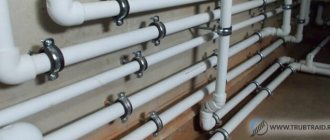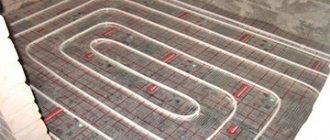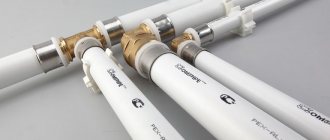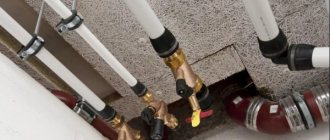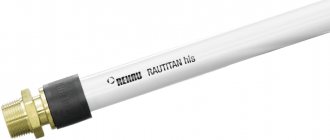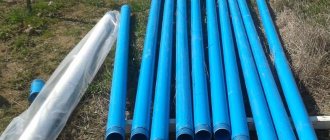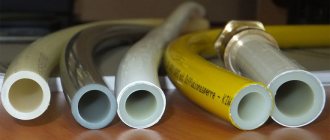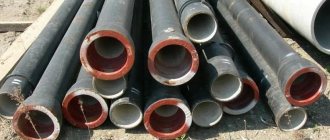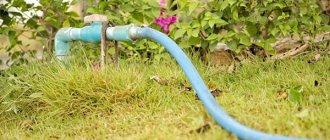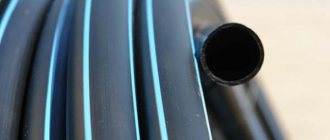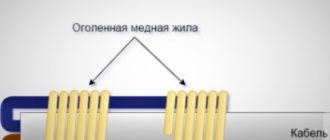Replacing outdated pipework in a water supply system begins with the selection of new materials. Products made of metal-plastic and polypropylene are similar in many ways. But the technical characteristics of the former allow us to carry out the necessary work on our own and without any difficulties. Metal-plastic pipes for water supply are flexible and inexpensive. They are used in laying sewerage systems and in industrial construction.
Performance characteristics
Pipes made of metal-plastic may have certain features, depending on the thickness of the products and the materials used. But we can highlight general properties that are characteristic of most of the species available today:
- the maximum pressure that the pipe can withstand is 25 atm;
- linear expansion coefficient is 0.26 at 10−4 1/°C;
- the roughness index is at 40.07;
- the strength of the welded joint with aluminum is 57 N/mm2.
Maintenance Tips
Compression fittings should be inspected once a year and the clamp nut should be tightened if necessary.
How to fix a leak
When installing on compression fittings, tighten the compression nut half a turn. The connection made by welding or using press fittings is permanent; you will have to cut out a piece of pipe and redo it using new fittings. Neither weld fittings nor press fittings can be reused, and the damaged piece of pipe will also have to be cut out.
Area of use
Metal-plastic pipes are used in various areas of industrial and civil construction. They are reliable, which is why they are used when installing water supply systems in private households and apartments. They are also suitable for:
- heating systems;
- arrangement of wells and wells;
- organizing watering of plants.
Pipes can be used when laying sewer systems and for supplying compressed air. Installation of these products does not require welding, so their installation is carried out in areas where welding work is prohibited. These materials are not suitable for rooms where powerful heating systems are located.
Sturm! TW7219
The welding machine is a real assistant for self-taught and professionals. Widely used in the field of plumbing work, it quickly and reliably joins pipe systems. Molten material does not stick to welding surfaces. There are 2 heating elements that can be turned on separately. The diameter of the nozzles varies between 20-63 mm. The device is equipped with a special heating panel, which is fixed into the groove of the casing. It is easy for a craftsman to work with a soldering iron thanks to the presence of a stand. The indicator indicates that the machine is heating up and turns off automatically when the maximum temperature is reached.
The advantages of the device are:
- Fast heating;
- Rich equipment;
- Low cost;
- High-quality coating of nozzles.
The disadvantages include:
- Heavy weight of the device;
- Weak scissors;
- Unsteadiness of the stand;
- Handle weakness.
When servicing the machine, use only original consumable parts and accessories. Otherwise, the device may break.
Advantages and disadvantages
If we look at the performance characteristics of metal-plastic pipes, we can understand why they are so in demand. Such products withstand any environmental changes. Their other advantages include:
- affordable price;
- flexibility;
- the ability to maintain shape under any circumstances;
- light weight;
- no need to use a welding machine due to the use of special fittings for fastening joints.
These pipes are not subject to corrosion, since their surface is made of polymer inside and outside. There are no lime deposits deposited on the inner layer, which is smooth. The tightness performance is also good. The pipe is reliable, and therefore does not let liquid out. It does not allow oxygen to enter. Contact with this gas is undesirable, as it can lead to the formation of rust on metal elements.
We can highlight a long service life, which is achieved under normal conditions of use of the products. In this case, it can reach 50 years. There is no unpleasant noise when liquid passes through the pipelines. In general, these structures look beautiful and aesthetically pleasing, and have low thermal conductivity.
Despite all these advantages, we also have to talk about disadvantages. Any kind of mechanical stress can lead to defects. Compared to metal, metal-plastic is not as resistant to water hammer.
Constant exposure to direct sunlight may reduce the service life of the products.
VALTEC ER-04
Plumbing tools are used for resistance welding of polypropylene pipes and couplings. Packed in a metal box along with a stand-bed, a level, a set of replaceable heating elements of different diameters, scissors, a tape measure and a hex key for fixing the dies. Instruction manual included. The electric soldering iron heats up in 10 minutes. On the body of the device there is an indicator light for turning on and controlling heating, the degree of which can be adjusted.
The welding equipment set has the following advantages:
- Power 1500 W;
- High quality replacement tips for precision soldering;
- Ability to connect parts of different sizes;
- The presence of a thermostat;
- Convenient transportation in a construction box.
Disadvantages include:
- Short power cord;
- Low quality nozzles;
- Inconvenient stand.
Components of the structure
It uses metal and plastic, which are connected using special technology. The finished pipe includes 5 layers, 2 of which act as a binding component, the remaining 3 are considered the main ones. The first layer, located inside, is made of polymer. The second binds several layers of material and is an adhesive. The third layer - aluminum - is reinforcing. The fourth is similar to the second. The fifth layer located on the outer side is the same as the first, made of polymer.
To put it simply, the pipe contains 2 layers of plastic, and between them there is a gap in the form of aluminum foil. It is required for materials to be more resistant to mechanical stress and durable. Plastic is needed to protect the aluminum from defects. The polymer is also responsible for the smoothness of the surface so that any liquid can move inside the pipes without obstacles.
Plastic is not subject to corrosion, and lime does not linger on it. This is important to ensure that throughput remains good throughout its lifespan. The polymer located on the outside fights condensation. Specialized adhesives are selected that have an optimal level of adhesion to metal and plastic. The area of use of the finished pipe and its service life depend on how well each of these layers is made.
Working with metal-plastic pipes
Installation and connection of metal-plastic pipes is carried out using collet or push fittings. The pipes are secured to the surface using special clips. The clip itself is fixed using self-tapping screws. To prevent the possibility of sagging of the mounted line, it is recommended to install clips in increments of one meter.
Before you start working with metal-plastic pipes, you need to prepare it. For this:
- The pipe is cut into pieces of the required length using a pipe cutter.
Installation of a “warm floor” system involves laying the structure into the floor under the screed.
Due to their technical characteristics (ductility, ability to withstand heavy loads, retains their structure when exposed to high temperatures, significant service life), metal-plastic pipes are optimally suited for installing heated floors. Since the installed system will be closed and there will be no access to it, it is recommended to use one-piece fittings when laying heated floors.
Installation of water meters on metal-plastic pipes is carried out using ball valves.
You can defrost a metal-plastic pipe at home using a hair dryer, but you should carefully ensure that the plastic does not overheat. The second option is to pour hot water over a frozen metal-plastic pipe; for this, the pipe is wrapped with some kind of rag and poured boiling water over it.
Aluminum thickness
This metal is present in the structure to protect its components from various damages, including fractures during installation, changes in fluid pressure and mechanical loads. It is important to prevent linear expansion and create a barrier to oxygen penetration. The thickness of aluminum in modern pipes can vary. Usually it is 0.15−0.6. It is undesirable to give preference to materials where aluminum has a layer less than 0.3 mm, since it is brittle.
It is better to purchase materials with values from 0.3 to 0.55 mm. If they have acceptable strength indicators, installation will not be a hassle. These pipes will remain flexible for a long time. When aluminum has a thickness of more than 0.55 mm, a lot of effort will have to be made during the installation process. Pipes are considered expensive, but experts recommend them as the most durable. After welding, the aluminum foil turns into a solid tube. To carry out such processing, you can resort to several methods:
- Laser welding. After it, the elements are joined end-to-end, and no seams are formed. Finished pipes have excellent performance properties and smooth walls. Aluminum can be of any thickness.
- Ultrasonic welding. The ends of the foil are overlapped here. To prevent excessive thickening in the areas where materials meet each other, the thickness of the aluminum in these areas should be reduced. Ensuring perfect evenness is problematic. Pipes prepared in this way are considered economical, but they are less durable compared to seamless ones. Their installation is more complicated, and their wear resistance indicators are not so impressive.
If there is a need to arrange systems that require great responsibility, you should opt for seamless models.
Polypropylene or metal-plastic - subtleties of choice
When choosing a heating system, homeowners are guided by the price of materials and the cost of installation work, which together gives the total cost. This factor plays an important role, which is quite natural given the current income of citizens. In this regard, PPR is better than metal-plastic, since it will cost at least half as much. If you take high-quality materials produced by well-known brands, then metal-plastic will cost three times more.
It is impossible not to touch upon the technical characteristics of metal-plastic and polypropylene. The most important are the operating maximum permissible pressure and water temperature in the pipeline. These parameters are interrelated, for example, a PP-R pipe will withstand a pressure of 10 Bar at a coolant temperature of 60 °C, and at 95 °C the pressure drops to 5.6 Bar. The higher the operating temperature, the shorter the service life of polypropylene, as shown in the table:
For comparison, let’s take the equally famous Belgian brand Henco, which offers high-quality metal-plastic pipelines reinforced with a solid layer of aluminum. Its operating characteristics are as follows: at a temperature of 95 °C, the maximum operating pressure is 10 Bar, and for some modifications of pipes it is 16 Bar. The given technical characteristics should be taken into account when choosing a material
It is also important to understand where its operation will take place:
- heating a private house;
- centralized heating system for the apartment;
- boiler room;
- warm floor.
Polypropylene is not used for water heated floors, only metal-plastic or cross-linked polyethylene.
Although some manufacturers (Valtec, Ekoplastik) have begun to produce polypropylene pipes for heated floors, metal-plastic remains the leader in this area. It is better in all respects, including heat transfer. PPR heating circuits transfer heat worse “thanks” to the large thickness of the pipeline walls.
What is better for a private home
Owners of cottages with several floors are recommended to turn their attention to metal-plastic. As a rule, such houses are built by developers with high requirements for the interior and the reliability of all engineering systems. Polypropylene manifolds and wiring will definitely not be able to meet these requirements due to difficulties with hidden gaskets. Metal-plastic can be safely installed under the floor and in other problem areas.
Polymers and central heating
The peculiarity of centralized heat supply is that the parameters of the coolant are unknown and can often reach maximum values. Despite this, many plumbers suggest that apartment owners install polypropylene for central heating, laying it in the grooves of the walls. Such solutions are risky; the material may not withstand a pressure drop or temperature jump and leak at the junction.
The optimal solution for an apartment is metal-plastic with press connections; PP-R is best installed on the water supply. Judge for yourself: apartment wiring cannot be called complicated or too long, so you won’t feel a big difference in price. But metal-plastic will give you reliability and durability, plus it can be hidden in a wall or floor, making the interior of the rooms more attractive.
Boiler room wiring
The piping of boilers and other thermal power equipment can be done with either polypropylene or metal-plastic. But there is a peculiarity here - the presence of a large number of turns and connections. It is difficult to do the wiring yourself using any polymer pipes, except that in the boiler room there is 1 wall-mounted heat generator that works only for heating. But even here everything needs to be done beautifully so that the pipes do not run at random.
An example of a beautiful PP-R wiring, the manifold is also welded from polypropylene tees
If a solid fuel boiler is used to heat a private house, then you can use polymers for its piping, but be careful. This means that some areas will have to be made of metal, for example:
- a piece of pipe from the heat generator to the safety group, when it is installed separately;
- the area where a surface-mounted temperature sensor working with a three-way valve is attached to the return line.
Types of plastic used
You can use different types of plastic to produce pipes. It can be linear or cross-linked polyethylene. Both of these options guarantee maximum reliability and durability. These materials are not afraid of loads and tolerate external influences well. Experts recommend these types of polyethylene for heating systems.
HDPE, or low-density polyethylene. It has a narrower scope of application. It can be used to transport cool water. With constant exposure to direct sunlight, the structure of the material can wear out, so it should be provided with adequate protection. This is an economical product that can last for decades if used correctly.
Binding component
To bind metal and plastic together, specialized compounds are used, through the use of which it is possible to create multilayer structures that form a single whole. It is difficult to accurately name the brand of glue, as well as the components included in its composition, since companies keep this information secret.
Buyers have no choice but to check the certificates for such products and make sure they are safe. The glue is used as a bonding layer and gives the product elasticity. This material is one of the most vulnerable points in the pipe. If elasticity decreases, the product will separate into layers and leak. The metal-plastic pipe must be equipped with a high-quality bonding layer. Delamination should not be noticeable on the cut of the material. Having discovered that the bonding of the constituent elements is not strong enough, it is hardly necessary to talk about the reliability of such a material.
Comparison of parameters
Metal-plastic and polypropylene pipes have different characteristics. Manufacturers have done their best, so even visually the materials are not similar to one another. Comparing the parameters will allow you to understand the difference between both models.
Performance characteristics
In terms of elasticity, polypropylene pipes are stiffer than types made of metal-plastic. Multilayer structures are easy to bend, making transportation and installation easier. With the same parameters, polymers have thicker walls than composites.
Installation of metal-plastic types Source dariusmehri.com
Inner and outer diameter
These are important parameters that must be studied before purchasing. The internal diameter is a property that represents the capacity of a pipe. The outer cross-section is indicated on most commercially available products. It is 16−63 mm. As for the wall thickness, it depends on the diameter. The larger it is, the higher this indicator. It is 2−3.5 mm. We can highlight the sizes of metal-plastic pipes that are considered the most popular:
- Modifications are 16 by 12. This means that the outer diameter is 16 mm and the inner diameter is 12 mm. The wall thickness of such products is 2 mm. These pipes are used to supply water to faucets and water meters. They are also used in other components of the water supply system. They can also be used for heating, but the pipes in this case must be of a larger diameter. The cheapest fittings with a cross section of 16 mm are available for these models.
- 20 by 16. These products have a wall thickness of 2 mm. They are characterized by good throughput. They can be used when installing heated floors or laying water pipes when water pressure is inconsistent.
- 26 by 20. The walls in such a pipe are 3 mm thick and are suitable for laying water supply and heating systems. They can be used when installing heated floors in a private home.
- 32 by 26. This option for the main water supply has a wall material thickness of 3 mm.
- 40 by 32. The wall here has a thickness of 3.9 mm. These are pipes for central heating and water supply. More often they are used in industrial engineering networks and in most cases are not suitable for private homes.
- 50 to 40. This is a suitable material for process piping. The wall of such a pipe has a thickness of 4 mm. Such sizes can be used on large industrial facilities. It is good to use them to supply compressed air.
- 63 mm or more. The scope of their use is specific.
DIOLD ASPT-4
A welding machine with a rated power consumption of 1500 W is widely used in everyday life. It is easy to use and allows you to quickly install a pipeline system for any purpose. The work is carried out using the method of polyfusion welding of sheet plastics. Seamless soldering ensures high connection strength. The delivery set includes the device, a stand, a set of 6 interchangeable dies (20, 25, 32, 40, 50, 63 mm), a screw, a socket wrench, a screwdriver, a tape measure, gloves, scissors, and technical documentation. Powered by a standard electrical outlet equipped with a fused socket.
The advantages of DIOLD ASPT-4 are:
- Decent equipment;
- Ergonomics;
- High heating rate;
- Reasonable price.
- Bad cutter;
- Poor quality tape measure and gloves;
- Small carrying case.
Top manufacturers
In the rating of metal-plastic water pipes, products made from PEX or PE-RT materials can be distinguished. They are considered durable. Russia, Italy and Germany specialize in the production of these products. Modifications from other countries also enter the domestic market. The following brands of metal-plastic pipes for water supply are considered the best:
- Nanoplast. The domestic company produces high-quality products, observing standards regarding hygienic and technical parameters.
- Valtec. This is a product jointly produced by Italy and Russia. The service life of metal-plastic water supply pipes of this type is quite impressive. The company's catalog contains a variety of plumbing products.
- Oventrop. Truly German quality. Pipes can be used for various types of engineering systems, for arranging heating and water supply at industrial facilities and in private homes.
The world famous Henco pipeline
Henco metal-plastic pipes combine all the advantages of metal and plastic pipes better than others. Due to this, they are used in a wide variety of engineering networks, namely:
- Cold and hot water supply;
- Heating;
- Conditioning;
- Heating of staircases, swimming pools, stadiums;
- Technological water treatment systems.
Henco metal-plastic pipe
Henco metal-plastic pipes are electrically safe, silent and easy to install products. The pipeline costs little money compared to how long it will last without the need for regular repairs and without loss of quality.
Heating materials
The pressure inside centralized heating systems can reach up to 4 atmospheres, while in autonomous ones this figure is rarely higher than 1.5 atm. Such operating conditions make it possible to use metal-plastic pipes for heating. In this case, the only limitation concerns the need to control the temperature in the house.
Such pipes have a minimal linear expansion rate, so when the liquid in them freezes, the metal-plastic material will be damaged. For the same reason, it is important to maintain constant heating in the premises. A solid fuel boiler is not suitable in this case, since the coolant will not have constant values. In this regard, a heat accumulator is recommended. It will prevent pipes from leaking.
Plumbing solution
There are no restrictions in terms of choosing metal-plastic pipes for water supply. But if you need to supply warm water, you should give preference to the linear version made of cross-linked polyethylene. Pipe marking is of particular importance. The type of material, operating pressure, product lot number and the name of the manufacturing plant should be displayed here. Before purchasing material, you need to find out what pressure indicators may exist for the water supply in the apartment.
In such a situation, water is used, which will also be used for drinking, so the material must be absolutely safe. This will be confirmed by certificates of compliance with hygienic standards.
The presence of foreign inclusions in the structure, as well as dents and scratches, is unacceptable.
